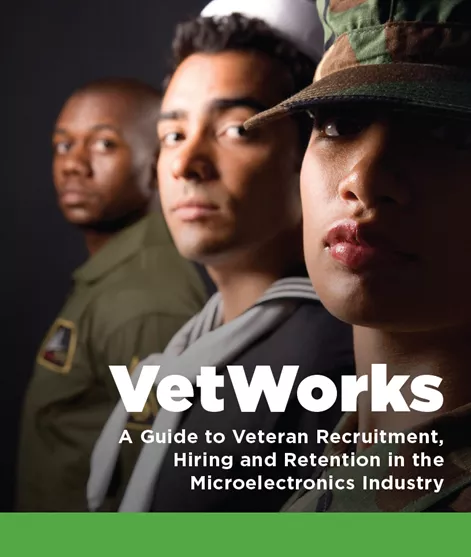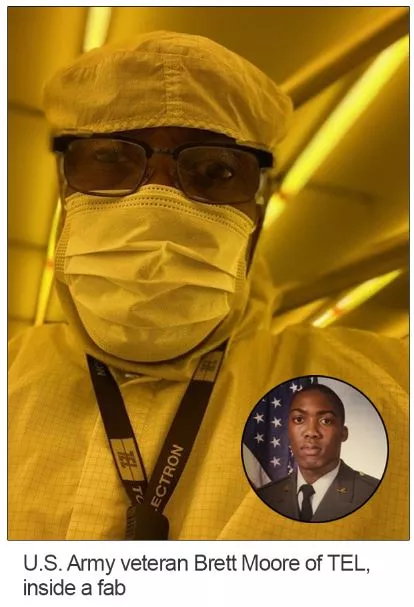
“Part of my calling, my passion is to help hire veterans, those that come from a similar background as mine who maybe wanted to serve their country, but not make it a career. And it’s often very intimidating and fearful to understand how that experience translates to an industry like ours.”
Larry Smith (U.S. Army veteran), president, TEL America
According to the U.S. Department of Veterans Affairs, nearly 200,000 service members transition out of the U.S. military annually. As the microelectronics industry looks to fill job vacancies, and as we approach Veterans Day, it’s important to turn our attention to the many contributions of veterans and why hiring them is both the right thing to do and a sound business strategy.
Transitioning members of the military represent a strong, diverse pool of highly motivated talent with many valuable skills and experiences directly translatable to and required by the semiconductor industry. Many SEMI member companies already have active recruitment and hiring practices in place for veterans, as well as robust internal programs to ensure retention of these highly skilled employees. Each company’s journey in hiring and retaining veterans is unique. Some are implementing their first initiative, while others have been doing this work for many years.
 As an industry, we can learn from companies that have been successful in this work, and support organizations that are just getting started in hiring vets. What’s most important for any company is to recognize the immense value that veterans bring to microelectronics and translate their military proficiencies that apply to our industry. These range from so-called soft skills, such as teamwork, communication, resilience, and commitment to a common goal, to advanced technical training. Veterans with these skills can be found in all branches of the military.
As an industry, we can learn from companies that have been successful in this work, and support organizations that are just getting started in hiring vets. What’s most important for any company is to recognize the immense value that veterans bring to microelectronics and translate their military proficiencies that apply to our industry. These range from so-called soft skills, such as teamwork, communication, resilience, and commitment to a common goal, to advanced technical training. Veterans with these skills can be found in all branches of the military.
To support companies in welcoming service members to the semiconductor industry, the SEMI Foundation has created VetWorks: A Guide to Veteran Recruitment, Hiring and Retention in the Microelectronics Industry. The guide includes recommendations, resources, and research that will help SEMI members connect with this vital talent pool. Following are some of the strategies outlined in the guide.
Make a Full-Company Commitment
Companies that have attracted and retained service members recognize that the work starts at the top. Executive support is key to any successful strategy. Make hiring military members a key business strategy, one that will be measured as goals are put in place. Once company leadership is on board – particularly those in human resources and management – it’s critical to communicate the strategy throughout the organization. Just like diversity, equity and inclusion, the journey requires all hands-on deck (to borrow a naval analogy).
Make Veterans Commitments Visible Internally and Externally
Companies can communicate their support for the veteran community by prominently promoting veteran programs on the company website and social media channels. The VetWorks guide also provides information and links on how to generate awareness beyond traditional networks, such as the U.S. Department of Labor’s Hire a Veteran website.
 Organizations can also engage with all branches of the military to get the word out and let Transition Assistance Program (TAP) officers know that they are hiring. The TAP’s mission is to support service members as they transition to civilian life. For excellent examples of other companies that have promoted their veterans programs, look to SEMI members such as Intel, Applied Materials and Qorvo. These companies celebrate their veteran and reservist employees by highlighting their stories, welcome veterans to explore careers in the microelectronics industry and offer assistance to veterans transitioning to civilian life.
Organizations can also engage with all branches of the military to get the word out and let Transition Assistance Program (TAP) officers know that they are hiring. The TAP’s mission is to support service members as they transition to civilian life. For excellent examples of other companies that have promoted their veterans programs, look to SEMI members such as Intel, Applied Materials and Qorvo. These companies celebrate their veteran and reservist employees by highlighting their stories, welcome veterans to explore careers in the microelectronics industry and offer assistance to veterans transitioning to civilian life.
Use Military Resources to Support Your Hiring Practices
Companies can consider becoming a U.S. Army Partnership for Youth Success (PaYS) Partner, which TEL recently became (see related announcement). Or they can help ease the transition from military to civilian careers through a crosswalk program that translates Military Occupational Specialty (MOS) codes to civilian job postings. Companies can also equate military experience with academic degrees through programs such as the Military Degree Equivalence program offered by Dow.
Train Your Hiring Team
 It is important to understand that veterans may be modest about their individual accomplishments as the service members are taught to focus on the team and the mission. It can be difficult for veterans to translate the proficiencies they developed while in the service to those required and sought after in the civilian workforce. Work to uncover their potential and encourage them to share their experiences. Keep in mind that unless an applicant was a ranking officer, the service member may never have interviewed for a job before and may be intimidated by the interview process.
It is important to understand that veterans may be modest about their individual accomplishments as the service members are taught to focus on the team and the mission. It can be difficult for veterans to translate the proficiencies they developed while in the service to those required and sought after in the civilian workforce. Work to uncover their potential and encourage them to share their experiences. Keep in mind that unless an applicant was a ranking officer, the service member may never have interviewed for a job before and may be intimidated by the interview process.
While service members are trained to deal with the unexpected, they may feel uncomfortable or out of their element competing in a corporate environment. Make sure your hiring team takes the time to understand each candidate’s skills and experience. One helpful practice is asking current veteran employees for guidance on interpreting military skills and experiences and how they might translate to current job openings.
Employ Strong Retention Practices
Two of the most important elements of welcoming veterans into the semiconductor industry are onboarding and retention. According to a 2017 article in the MUMA Business Review, 20% to 35% of veterans leave their first job within two years. The attrition often stems from veterans feeling that their contributions are not recognized or that they are out of sync in a civilian environment, not because of an inability to do the job. One crucial step is connecting veteran new hires with a mentor who has a military background. Employee/Veteran Resource Groups (E/VRG) for veterans are also tremendously helpful. If you don’t have an ERG for veterans, create one.
The new SEMI VetWorks guide offers other recommendations and resources for any company looking to recruit veterans. Invest in your veteran and active reservist employees by recognizing their abilities and showing them a path to career growth at your company.

To learn more, download the SEMI VetWorks guide. Company leadership, hiring managers, and all employees wishing to support veterans are encouraged to participate in the SEMI Foundation VetWorks webinar to learn more about the guide and hear perspectives from a talent recruiter and veteran at TEL. Please join us on November 16, 2021 at 10:30 a.m. Pacific Time.
Margaret Kindling is senior program manager of Diversity, Equity and Inclusion at SEMI.